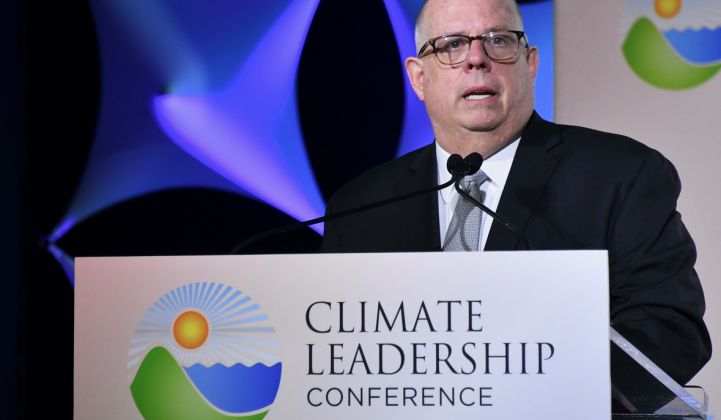Maryland will raise its renewable electricity requirement from 25 percent by 2020 to 50 percent by 2030.
The legislature passed the Clean Energy Jobs Act last month to enact this change, and it has been sitting on the desk of Governor Larry Hogan, a Republican. He chose to neither sign nor veto it within a 30-day window, which allows it to become law, The Baltimore Sun reported.
Hogan previously vetoed a renewable portfolio standard increase in 2016, on the grounds that it imposed too much additional cost for customer electricity bills. The legislature overrode his veto in 2017.
The new bill raised a few concerns. A state analysis suggested it would add $1.50 per month to the average customer's bill, due to the requirement that utilities purchase renewable energy credits. That gave conservatives reason to attack it. It also subsidizes trash incineration as a renewable source of power, angering environmentalists.
Hogan, however, objected that it did not go far enough in cleaning up the state's grid and nurturing clean energy jobs locally.
"Despite its name, this bill is not clean enough, nor smart enough, nor does it create the intended jobs within Maryland," he wrote in a letter Wednesday to Senate President Thomas V. Miller. "Instead, it is a rushed and deeply flawed proposal, in need of significant improvements."
Rather than veto, Hogan said he would allow the bill to become law without a signature in the hopes of crafting a better clean energy policy down the road.
To that end, he suggested a more ambitious target of 100 percent clean electricity by 2040. This would incorporate nuclear power as a clean generation source, rather than limiting the options to renewable sources. Only Hawaii, California, New Mexico and Washington have committed to fully carbon-free grids.
Hogan promised he would submit his Clean and Renewable Energy Standard at the start of the next legislative session in 2020. His letter did not explain the motivation for waiting until this legislative session had concluded to propose a different framework for the state's clean energy policy.
The Calvert Cliffs nuclear plant produced 44 percent of Maryland's net electricity generation in 2017, according to the Energy Information Administration. Hogan's CARES proposal would allow that to continue and recognize the plant's clean energy contributions.
Maryland draws about half of its generation from fossil fuels and 10 percent from renewables.
Maryland utilities also import power from out of state, which explains the discrepancy between in-state renewables and the renewable portfolio standard.
Renewables industry groups celebrated the passage of the bill, pushing back on the various critiques.
“The long-term effects of this law will green the state’s energy system, create well-paying jobs and help consumers save money on their electrical bills," said John Finnerty, director of business development for Rockville, Maryland-based Standard Solar, in a statement.
Maryland hosts more than 1 gigawatt of installed solar, with another gigawatt expected over the next five years, according to the Solar Energy Industries Association.
The new legislation establishes a 14.5 percent solar carve-out, the largest of its kind, noted solar analyst Austin Perea of Wood Mackenzie Power & Renewables. The policy will create more upside for distributed solar than utility-scale, he predicted.
"Though utility-scale PV is eligible for the RPS, land-use constraints and restrictive zoning laws have increasingly become an issue for ground-mount systems, including commercial and community solar, which limits the upside opportunity for large-scale solar," Perea said.
The mid-Atlantic state has awarded renewable energy credits to two offshore wind projects totaling 368 megawatts, expected online in the early 2020s, and it has the potential to sign contracts for much more capacity in the years ahead. Wind companies cheered the bill's support for an additional 1,200 megawatts of offshore wind development.




